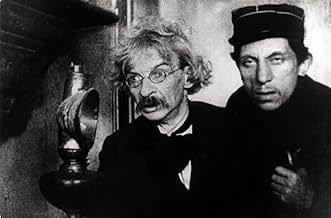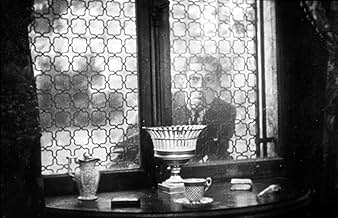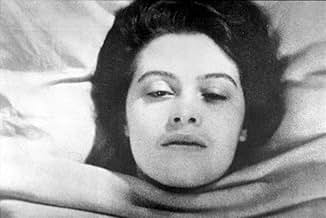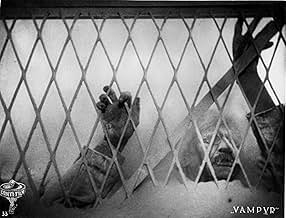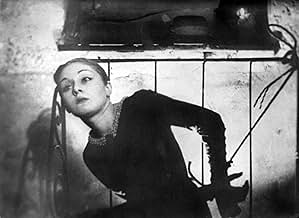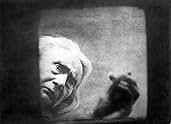NOTE IMDb
7,4/10
22 k
MA NOTE
Un vagabond obsédé par le surnaturel tombe sur une auberge où une adolescente gravement malade se transforme peu à peu en vampire.Un vagabond obsédé par le surnaturel tombe sur une auberge où une adolescente gravement malade se transforme peu à peu en vampire.Un vagabond obsédé par le surnaturel tombe sur une auberge où une adolescente gravement malade se transforme peu à peu en vampire.
- Réalisation
- Scénario
- Casting principal
- Récompenses
- 1 victoire au total
Henriette Gérard
- Die alte Frau vom Friedhof (The Old Woman from the Cemetery)
- (as Henriette Gérard)
Kani Kipçak
- Michael
- (non crédité)
Avis à la une
Since I was a kid interested in foreign and older films, I've been haunted by this picture. I remember seeing a shot of the back of a woman's head. She slowly turns around to reveal black lips, darkened eyes, and a smile of someone possessed of the vampire spirit.
Later, in school, I had the pleasure of seeing more of Dreyer's work. He didn't make any more 'horror pictures' to my knowledge, but everything else I saw had the same brooding, eerie sense, the same lack of interest in a driving plot, and the same photographic expertise that kept me enthralled when I first saw this picture.
He's considered one of the masters. He's not to everyone's taste. But, with VAMPYR, he got to me before I ever learned how to say the word 'cinema.'
Later, in school, I had the pleasure of seeing more of Dreyer's work. He didn't make any more 'horror pictures' to my knowledge, but everything else I saw had the same brooding, eerie sense, the same lack of interest in a driving plot, and the same photographic expertise that kept me enthralled when I first saw this picture.
He's considered one of the masters. He's not to everyone's taste. But, with VAMPYR, he got to me before I ever learned how to say the word 'cinema.'
For a movie made in 1932, this is very, very impressive. Confusing plot aside, the emphasis in this Victorian nightmare is placed on the cinematic aspects. "Vampyr" is plodding, very dark and eerie, filled with such haunting atmosphere and brooding visuals full of unseen, but lurking terror - very effecting. It works on a subconscious and emotional level more than any other way. I think it's worth a look.
Too often horror films are thought of as light-weight entertainment. Even the best are under-appreciated for what they can tell us about human nature. In the case of Carl Dreyer's "Vampyr," however, all you seem to hear is high-brow rhetoric about how the film's dream-like illogic makes it a meditation upon death. For just once forget all the intellectual mumbo-jumbo and watch this film for what it is, one creepy little flick and the pioneering vampire film of the '30s. It was in production a year before "Dracula" but released the year after, and is a better and scarier film, unless bats on strings scare you.
It's not a silent movie but feels like one - an exceptionally fine one. So if you are put off by non-talking films be warned, dialog is spare, cut to the bone; but the musical score is very good and sinister. The main attractions are the images: shadows that kill people, a spirit that leaves its body, a corpse-eye view of a burial, and other uncanny occurrences that lead young Allan Grey to a girl suffering from a mysterious illness, and to her doctor, a vampire's accomplice who supplies his crone-like patroness with fresh victims.
Possibly the film's poor reception by critics and audiences was because the 1930 soundtrack was too primitive to be appreciated by viewers in 1932, who by then were used to lots of chatter - and because the earlier release of "Dracula" blunted its impact. But with little dialog and without the stagnating influence of a stationary microphone our eyes feast on Hermann Warm's eerie art direction, and are guided by Rudolph Mate's camera, which keeps us off balance, misdirecting our point of view as when it pans to a door through which a nurse exits her patient's room, then pans back again to reveal an empty bed just before the victim's sleep-walking rendezvous with the vampire.
The film bears even less resemblance to its source (Sheridan Le Fanu's "Carmilla") than "Dracula" does to Stoker's novel, possibly because it borrows from another story, Mary Elizabeth Braddon's "Good Lady Ducayne," in which a young man comes to the aid of a young paid female companion of an extremely aged woman whose doctor draws the young woman's blood for his patient to consume. And if "Vampyr's" plot often seems incoherent, so does "Dracula's." The performances, however, are vastly superior. Sybille Schmitz in particular, as the vampire's victim, conveys with her subtle expressions emotions for which spoken language is inadequate.
For those who already know this film, Martin Koerber's restoration on the Criterion release eliminates the large, black-bordered, Gothic subtitles, and corrects the too-bright day-for-night scenes that were so distracting on the Image disc. For others seeing "Vampyr" for the first time, relax, don't think too much, and enjoy!
It's not a silent movie but feels like one - an exceptionally fine one. So if you are put off by non-talking films be warned, dialog is spare, cut to the bone; but the musical score is very good and sinister. The main attractions are the images: shadows that kill people, a spirit that leaves its body, a corpse-eye view of a burial, and other uncanny occurrences that lead young Allan Grey to a girl suffering from a mysterious illness, and to her doctor, a vampire's accomplice who supplies his crone-like patroness with fresh victims.
Possibly the film's poor reception by critics and audiences was because the 1930 soundtrack was too primitive to be appreciated by viewers in 1932, who by then were used to lots of chatter - and because the earlier release of "Dracula" blunted its impact. But with little dialog and without the stagnating influence of a stationary microphone our eyes feast on Hermann Warm's eerie art direction, and are guided by Rudolph Mate's camera, which keeps us off balance, misdirecting our point of view as when it pans to a door through which a nurse exits her patient's room, then pans back again to reveal an empty bed just before the victim's sleep-walking rendezvous with the vampire.
The film bears even less resemblance to its source (Sheridan Le Fanu's "Carmilla") than "Dracula" does to Stoker's novel, possibly because it borrows from another story, Mary Elizabeth Braddon's "Good Lady Ducayne," in which a young man comes to the aid of a young paid female companion of an extremely aged woman whose doctor draws the young woman's blood for his patient to consume. And if "Vampyr's" plot often seems incoherent, so does "Dracula's." The performances, however, are vastly superior. Sybille Schmitz in particular, as the vampire's victim, conveys with her subtle expressions emotions for which spoken language is inadequate.
For those who already know this film, Martin Koerber's restoration on the Criterion release eliminates the large, black-bordered, Gothic subtitles, and corrects the too-bright day-for-night scenes that were so distracting on the Image disc. For others seeing "Vampyr" for the first time, relax, don't think too much, and enjoy!
With its fragmented plot, eerie imagery, and air of undefined menace this film more nearly realises the dream state than any other film I've seen.
The story, which follows a young man's discovery of vampiric doings while on a trip to the country, is secondary to the fascinatingly uncanny mood generated by the cinematography and effective use of sound and silence.
Yes, yes, it's old and unconventional, and requires either some extra concentration or complete surrender to its unique world, but the effort is worth it.
Vampyr should especially appeal to fans of cinefantastique, cinema history and maybe even the arthouse crowd.
The story, which follows a young man's discovery of vampiric doings while on a trip to the country, is secondary to the fascinatingly uncanny mood generated by the cinematography and effective use of sound and silence.
Yes, yes, it's old and unconventional, and requires either some extra concentration or complete surrender to its unique world, but the effort is worth it.
Vampyr should especially appeal to fans of cinefantastique, cinema history and maybe even the arthouse crowd.
It is understandable that many take issue with Vampyr due to an absence of conventional moviemaking factors that make an average film watchable. However, I believe that this is more a problem of the viewer than one with the filmmaker, and it all begins with whether or not one watches expecting to be frightened in a generic horror flick manner. This is not a scary movie; it is one that fundamentally blurs the lines between dreams and reality. It is not a silent film or a talkie, but something in between, and that fits in perfectly with the idea of it being an experience much like a bad dream. There are few professional actors (two, in fact, and neither would be considered the leading actors), and long takes that would drive a Hollywood film editor to distraction. They are selected more for their appearance and natural manner than for any exceptional gift as an actor/actress, and it is my belief that that adds more than detracts from the experience. The reactions of the characters are far more visceral and simple than in most films of this depth, and it helps create the mesmerizing, hypnotic effect few movies can create. It is designed, I believe, to be seen in a dark room, preferably alone and late at night, just prior to going to bed. If the viewer is a little sleepy, so much the better: for the true power of the film will only be revealed as you dwell on it afterwards while you struggle to go to sleep. Then,and only then, will the full might of Carl Theodore Dreyer's vision be revealed.
Le saviez-vous
- AnecdotesFor much of the cast, this was their only film appearance, since they were not professional actors. Henriette Gérard, who played the vampire, was a French widow, Jan Hieronimko, who played the village doctor, was a Polish journalist, and Rena Mandel, who played Gisèle, was an artist's model. Julian West (real name: Baron Nicolas de Gunzburg), who played Allan Grey, was a French-born member of Russian nobility who agreed to finance the film in exchange for the leading part. (He later emigrated to America where he became a powerful fashion journalist and mentor to designers like Calvin Klein.)
- GaffesAt exactly 16 minutes (in the Criterion DVD) as the camera pans right, there is a reflection in a glass window of the camera operator cranking the camera.
- Versions alternativesThere is an Italian edition of this film on DVD, distributed by DNA srl, "LA STRANA AVVENTURA DI DAVID GRAY (Vampyr - Il vampiro, 1932) + NOSFERATU, UNA SINFONIA DELL'ORRORE (1922)" (2 Films on a single DVD), re-edited with the contribution of film historian Riccardo Cusin. This version is also available for streaming on some platforms.
- ConnexionsEdited into Dr. Terror's House of Horrors (1943)
Meilleurs choix
Connectez-vous pour évaluer et suivre la liste de favoris afin de recevoir des recommandations personnalisées
- How long is Vampyr?Alimenté par Alexa
Détails
- Durée1 heure 15 minutes
- Couleur
- Rapport de forme
- 1.19 : 1
Contribuer à cette page
Suggérer une modification ou ajouter du contenu manquant

Lacune principale
By what name was Vampyr, ou l'étrange aventure de David Gray (1932) officially released in India in English?
Répondre



